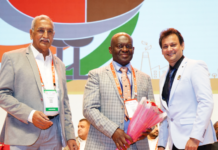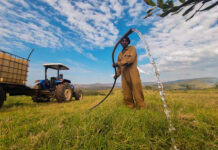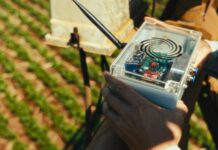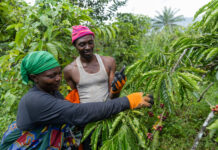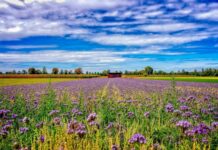![1[1]](https://farmersreviewafrica.com/wp-content/uploads/2025/10/11-696x928.jpg)
Tru-Cape producer Ruhan Hauman, fifth-generation farmer on his family’s farm Diepgat in the Hemel-en-Aarde Valley, has achieved his best crop ever in 2025—both in yield and pack-out percentage—thanks to his pioneering shift to regenerative farming practices.
On the farm’s 25 hectares of apples and pears, alongside onions and a Jersey dairy supplying milk to Fairview for cheese making, Hauman is transforming the way fruit is grown in South Africa. His results show that farming with nature, rather than against it, can deliver record harvests while cutting costs.
A former professional rugby player who played for French club Brive, Hauman returned to Diepgat in 2019 with a fresh perspective on food and farming. “In Europe, people care deeply about where their food comes from and how it’s grown,” he explains. “When I had to order pesticides in my first week back, I lost sleep over it. It didn’t feel right. I wanted to farm in a way that builds life, not destroys it. To eliminate pesticides, I had to start by building soil health and diversity.”
Hauman never studied agriculture formally, but immersed himself in books, research, and documentaries such as Kiss the Ground and What Your Food Ate. To ensure buy-in, he encouraged his father, Len, and their team to share in his vision. “There are not many regenerative fruit farmers in South Africa, so trials were the only way forward. Seeing is believing,” he says.
Closing the loop
Hauman began by dividing orchards into blocks and testing different soil treatments: two types of organic fertiliser, compost made from cattle and chicken manure, manure water from the farm’s dairy, and, as a control, conventional fertiliser.
“The manure water and compost combination gave by far the best results,” he explains. “Incredibly, everything we need is already here on the farm—we just had to use it better. Closing the loop has also cut our production costs dramatically.”
No synthetic fertiliser has been applied on Diepgat since 2022.
Cover crops and grazing
Next, Hauman focused on reducing ground pesticides by encouraging natural cover crops. Clovers, which fix nitrogen in the soil, flourished on their own. To enhance soil fertility further, he integrated two herds of Jersey heifers into the orchards from post-harvest to bud break. Not only are their urine and manure valuable to the soil, but also their hoof action and utilization of cover crops.
“It was incredible to see the change,” he says. “We allow the cows to graze about two-thirds of the vegetation. Clover and other favourable species pop up without sowing, and the effect on the soil is visible.”
The benefits go beyond fertility. With healthier soils and lush cover crops regulating temperature, Hauman now irrigates once a week instead of three times—cutting water use by nearly a third in a water-scarce country. Pollination has also improved, allowing him to halve the number of beehives required per hectare.
To protect irrigation systems, lines were lifted off the ground, and during summer, the cover crops are mechanically mowed. “Healthier soil leads to healthier plants with better pest and disease resistance,” he says.
Improved crops at lower cost
Hauman’s next mission is to reduce chemical inputs in the trees themselves. He is experimenting with softer mineral oils, environmentally friendly sprays, and strict monitoring of insect traps to avoid unnecessary spraying. A flock of ducks keeps snail populations under control. At some point, he wants to introduce natural predators to keep insects at bay as well.
The return of biodiversity is clear: dung beetles, egrets, earthworms, and even fish eagles have become regular sights on Diepgat. “The gradual improvement over the past three years has been the most rewarding. Our latest crop was our best yet, even as neighbouring farms had only average seasons. Both yield and pack-out improved, while input costs dropped significantly. It proves that healthier soils grow better fruit,” he says proudly.
For Hauman, regenerative farming is about more than economics. “It’s not about chasing organic certification or premiums. It’s about doing the right thing. And about balance—healthy soil, healthy trees, healthy fruit, and ultimately healthy people. We want to leave the land better than we found it.”
He adds that growing consumer demand for environmentally friendly practices, alongside tighter regulations on agrochemicals, may unlock new market opportunities for regenerative fruit.
Roelf Pienaar, Managing Director of Tru-Cape, South Africa’s largest exporter of apples and pears, applauds Hauman’s pioneering work.
“By rethinking long-standing practices, Ruhan is proving that fruit farming can be profitable, productive, and environmentally restorative. His success speaks directly to what Tru-Cape stands for. Our logo features a ladybug—‘Nature’s Helper’—as a reminder that farming works best when it is in harmony with nature. What Ruhan is doing on Diepgat is a real-life example of that philosophy in action. It shows how growers can reduce inputs, support biodiversity, and still deliver excellent harvests. That is the future of fruit farming.”
For more information, please contact Lucille Botha at lucilleb@tru-cape.co.za or visit www.tru-cape.com. Follow Tru-Cape on X (@TruCapeFruit), Facebook (@Tru-Cape Fruit Marketing), TikTok (@trucape), and Instagram (@trucapefruit).


